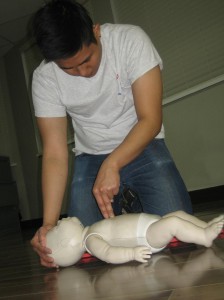What are the techniques for First aid for chocking in infants?
There are many dangers that are associated with chocking, especially in small kids, and this is what makes it extremely important to have know the latest rescue techniques for infant choking emergencies.
Some of the signs that you ought to be on the lookout for include:
- A weak distant cough
- The infant is unable to cry at all.
- A pale-blue coloration on the skin (this is testament to insufficient oxygen in the body).
- Faint sounds are heard when the infant breathes in.
*The material posted on this page on this page on choking recognition and management for infant victims is for learning purposes only. To learn to effectively and quickly recognize and manage partially and fully obstructed airways for victims of all ages enroll in a classroom first aid and / or CPR course today.
Steps to follow when carrying out management of chocking in infants
Point to note is that these steps must not be carried out if the infant has a strong forceful cough. If an infant has a forceful cough it is a partial obstruction and may be relieved with the coughing. The following steps are to be taking when the child no longer has an effective cough and silent / near silent.
1) Place the infant on your forearm so that they are face down. Provide support to your forearm with your lap. Place your hand such that it holds the infant’s chest, and your fingers support the jaw. Tilt the head of the

infant downwards so that its position is much lower than the rest of the body.
2) Provide 5 forceful punches in quick succession at the exact location that is between the shoulder blades of the infant. You will do this with the heel of the other hand.
3) Subsequent steps for first aid for chocking in infants are to be carried out if the object still has not been dislodged. Turn the infant so that they are now facing up, and use your thigh to provide much-needed support. Put your fingers on the breastbone and give 5 rapid thrusts that will serve to compress the infant’s chest.
4) You will repeat these thrusts until the object that causes chocking is eliminated. In case the infant becomes unconscious, stop the thrusts as this could only serve to make the situation worse.
5) The next step in the procedure for First aid for chocking in infants is that you should eliminate the object that causes chocking on only one condition, and that is if you can see it.
6) Avoid coming in the way if the infant has sudden bouts of coughing or if they suddenly start crying. You must be prepared, however, to step in if the symptoms start to get worse.
7) In the event that the child becomes unconscious, or suddenly their breathing ceases, call for help and go ahead and administer infant CPR.
The importance of knowing First aid for chocking in infants cannot in any way be underestimated. It could actually be the difference between life and death. Owing to its importance, it becomes necessary for individuals to know at least the basic steps. The training for this form of first aid is relevant to just about anyone, but especially parents, babysitters and nannies as well as day care center managers. If need be, get the family trained as well, you never know when the need will arise.
